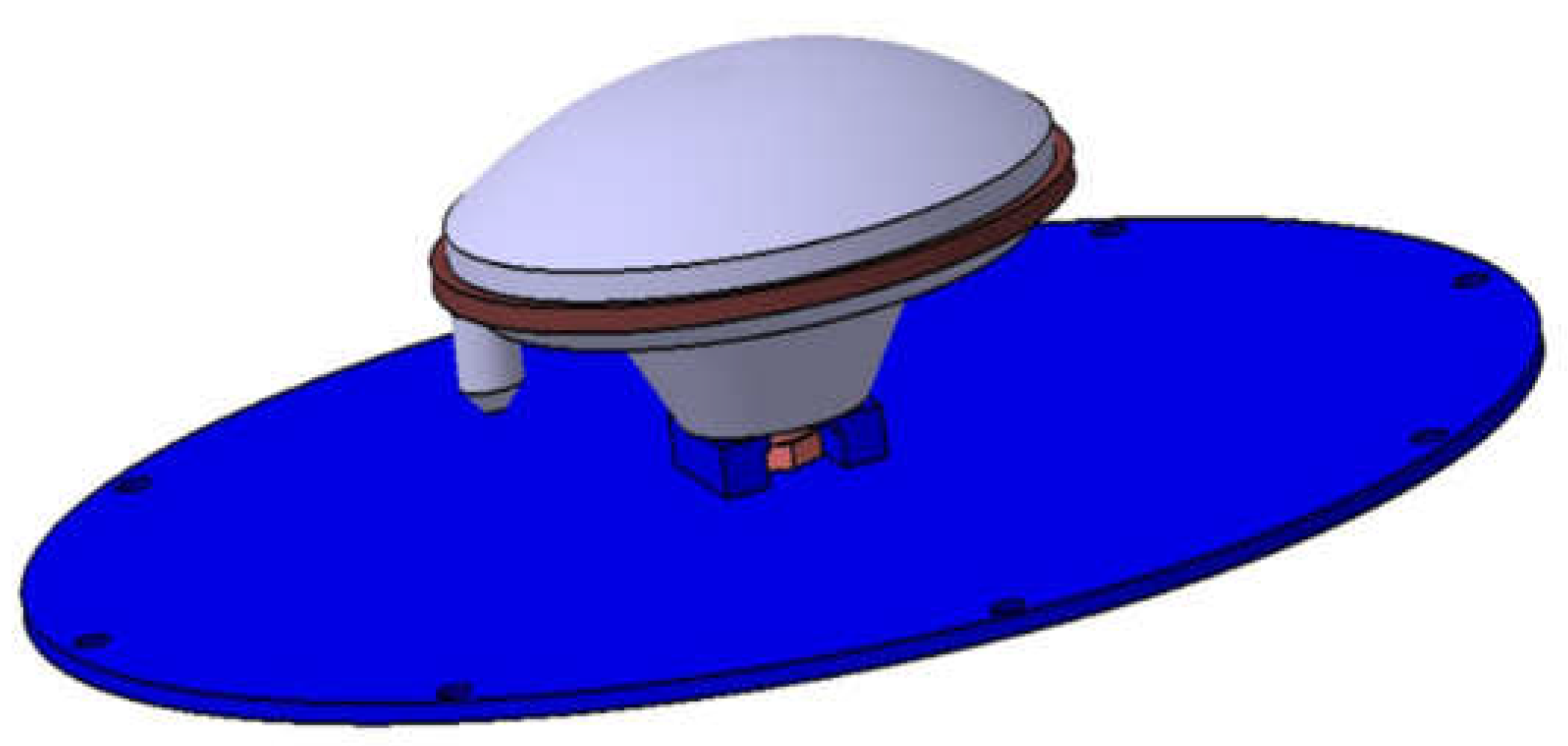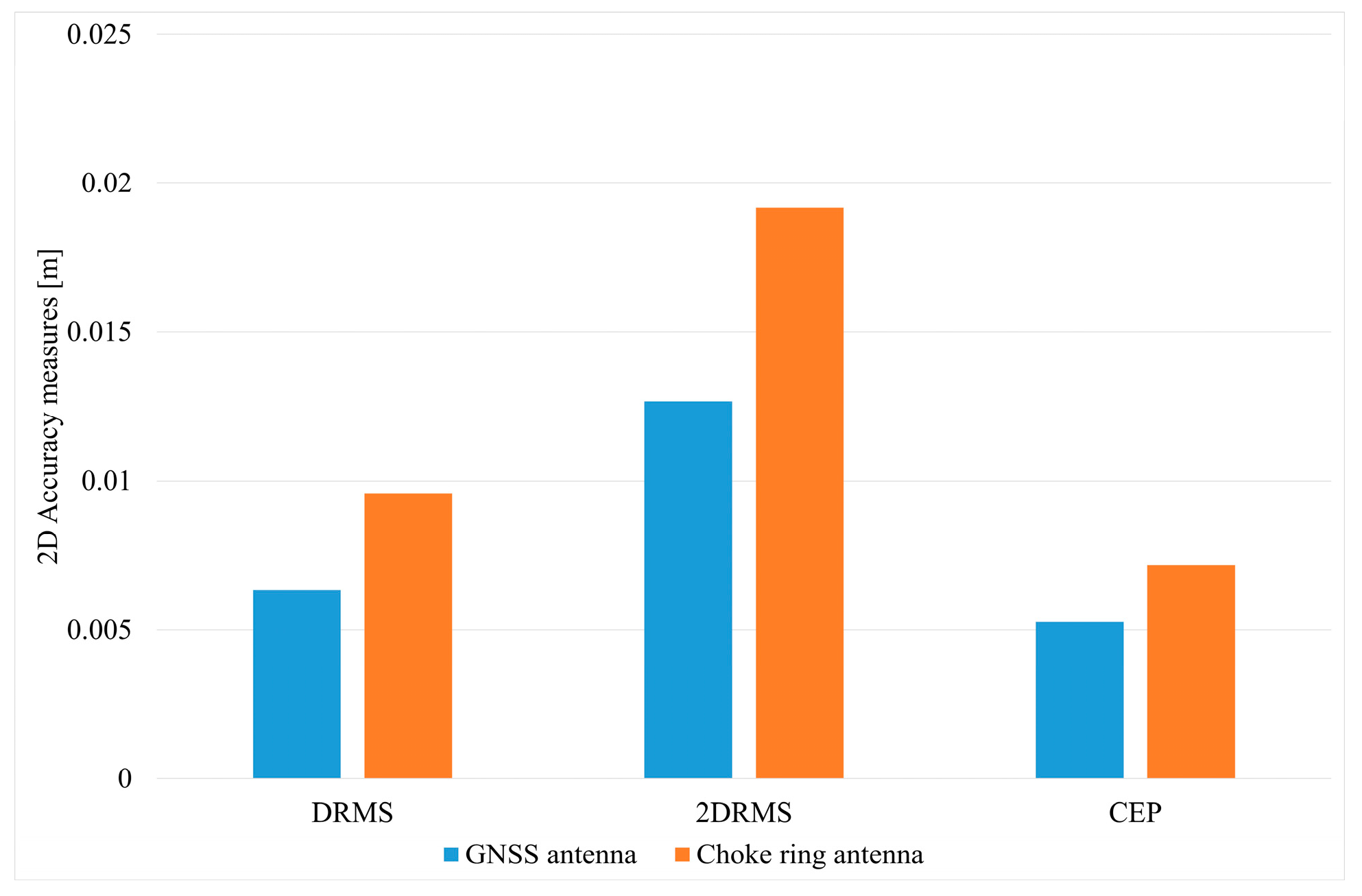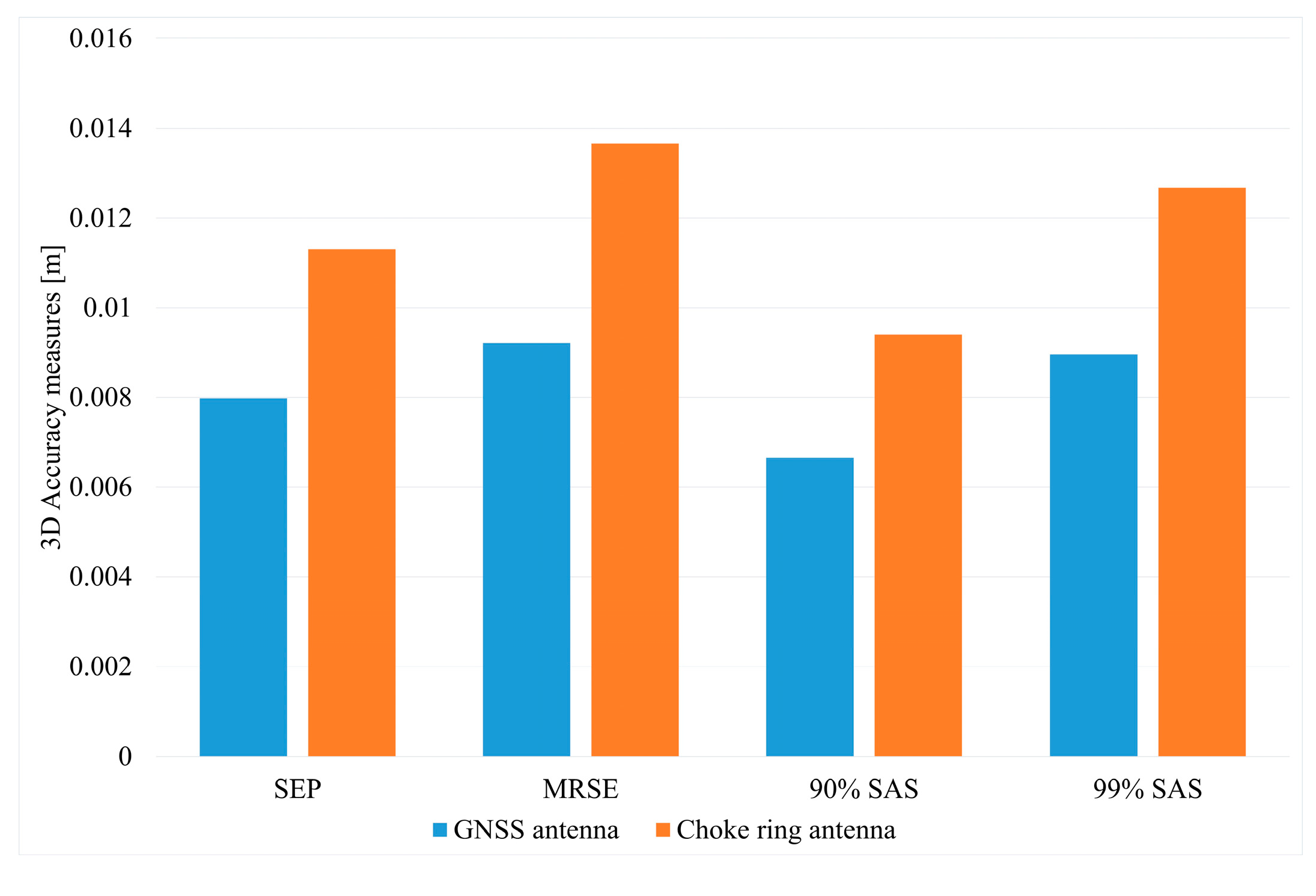Research on the Positioning Performance of GNSS with a Low-Cost Choke Ring Antenna
Abstract
:1. Introduction
2. Materials and Methods
2.1. Design of Choke Ring Antenna
2.2. Research Methodology
2.3. Indicators of the Quality of the Satellite Constellation
- PDOP (Positional Dilution of Precision),
- HDOP (Horizontal Dilution of Precision),
2.4. Accuracy Measures
- DRMS (Distance Root Mean Squared)
- 2DRMS (Two Distance Root Mean Squared)
- CEP (Circular Error Probable)
- MRSE (Mean Radial Spherical Error)
- 90% SAE (Spherical Accuracy Standard)
- 99% SAE (Spherical Accuracy Standard)
3. Results and Discussion
4. Conclusions
Author Contributions
Funding
Institutional Review Board Statement
Informed Consent Statement
Data Availability Statement
Conflicts of Interest
Appendix A






References
- Januszewski, J. GPS Satellite Systems, Galileo and Others; PWN: Warsaw, Poland, 2007. (In Polish) [Google Scholar]
- Narkiewicz, J. GPS and Other Satellite Navigation Systems; WKiŁ: Warsaw, Poland, 2007. (In Polish) [Google Scholar]
- Katulski, R. Radio Wave Propagation in Wireless Telecommunications; WKiŁ: Warsaw, Poland, 2009. (In Polish) [Google Scholar]
- Kruszewski, P. Satellite Navigation in Practice; KaBe: Krosno, Poland, 2016. (In Polish) [Google Scholar]
- Perski, A.; Wieczyński, A.; Baczyńska, M.; Bożek, K.; Kapelko, S.; Pawłowski, S. Odbiorniki GNSS w praktyce inżynierskiej. Wpływ typu anteny na jakość pomiarów GNSS. Pomiary Automatyka Robotyka 2013, 17, 106–122. (In Polish) [Google Scholar]
- Xu, G.; Yan, X. GPS: Theory, Algorithms and Applications; Springer: Berlin, Germany, 2016. [Google Scholar]
- Antennas. Available online: https://gssc.esa.int/navipedia/index.php/Antennas (accessed on 4 November 2022).
- GPS & GNSS Antennas. Available online: https://novatel.com/products/gps-gnss-antennas#overview (accessed on 4 November 2022).
- Rao, B.R.; McDonald, K.; Kunysz, W. GPS/GNSS Antennas; Artech House: London, UK, 2013. [Google Scholar]
- Liu, S.; Li, D.; Li, B.; Wang, F. A compact high-precision GNSS antenna with a miniaturized choke ring. IEEE Antennas Wirel. Propag. Lett. 2017, 16, 2465–2468. [Google Scholar] [CrossRef]
- Zhang, L.; Schwieger, V. Investigation of a L1-optimized choke ring ground plane for a low-cost GPS receiver-system. J. Appl. Geod. 2018, 12, 55–64. [Google Scholar] [CrossRef]
- 3D Choke Ring Antenna HX-CGX601A. Available online: https://www.orbitica.com/harxon/pdf-harxon/HX-CGX601A.pdf (accessed on 4 November 2022).
- Choke Ring Antenna Calibrations. Available online: https://kb.unavco.org/kb/article/choke-ring-antenna-calibrations-311.html (accessed on 4 November 2022).
- Kos, T.; Markezic, I.; Pokrajcic, J. Effects of multipath reception on GPS positioning performance. In Proceedings of the ELMAR-2010, Zadar, Croatia, 15–17 September 2010; IEEE: Piscataway, NJ, USA; pp. 399–402. [Google Scholar]
- Trimble GNSS Ti-V2 Choke Ring Geodetic Antenna. Available online: https://realtimenetworks.trimble.com/Trimble-Choke-Ring-Antenna.aspx (accessed on 4 November 2022).
- Leica AR25 GNSS Antenna. Available online: https://leica-geosystems.com/products/gnss-reference-networks/antennas/leica-ar25 (accessed on 4 November 2022).
- Leica AR25 White Paper. Available online: https://ngc.com.ua/files/PDF/Leica%20AR25%20TPA%200902%20en.pdf_Media.pdf (accessed on 4 November 2022).
- Emara, M.K.; Madhoun, K.; Madhoun, R.; Gupta, S. A low-cost light-weight 3D-printed choke ring for multipath mitigation for GNSS antennas. In Proceedings of the 2019 IEEE International Symposium on Antennas and Propagation and USNC-URSI Radio Science Meeting, Atlanta, Georgia, USA, 7–12 July 2019; IEEE: Piscataway, NJ, USA; pp. 721–722. [Google Scholar]
- Lin, D.; Wang, E.; Wang, J. New Choke Ring Design for Eliminating Multipath Effects in the GNSS System. Int. J. Antennas Propag. 2022, 2022, 1527674. [Google Scholar] [CrossRef]
- Scire-Scappuzzo, F.; Makarov, S.N. A low-multipath wideband GPS antenna with cutoff or non-cutoff corrugated ground plane. IEEE Trans. Antennas Propag. 2009, 57, 33–46. [Google Scholar] [CrossRef]
- Sawyer, D.J.; Das, S.; Diamanti, N.; Annan, A.P.; Iyer, A.K. Choke rings for pattern shaping of a GPR dipole antenna. IEEE Trans. Antennas Propag. 2018, 66, 6781–6790. [Google Scholar] [CrossRef]
- Davuluri, A.J.; Polepalli, S. A High Gain Ku Band Antenna with Circular Polarization Using Hybrid Choke Ring Structure. IETE J. Res. 2021, 1–10. [Google Scholar] [CrossRef]
- Karabulut, M.F.; Aykut, N.O.; Akpınar, B.; Topal, G.O.; Çakmak, Z.B.; Doran, B.; Zafer, A. The positioning performance of low-cost GNSS receivers in the Precise Point Positioning method. Adv. Geod. Geoinf. 2022, 71, e29. [Google Scholar]
- Sharma, H.; Bochkati, M.; Pany, T. Influence of the multipath mitigation on precise positioning with smartphone raw GNSS measurements. In Proceedings of the ISGNSS, Jeju, Republic of Korea, 29 October–1 November 2019; pp. 76–83. [Google Scholar]
- Danskin, S.; Bettinger, P.; Jordan, T. Multipath mitigation under forest canopies: A choke ring antenna solution. For. Sci. 2009, 55, 109–116. [Google Scholar]
- Blum, R.; Bischof, R.; Sauter, U.H.; Foeller, J. Tests of reception of the combination of GPS and GLONASS signals under and above forest canopy in the Black Forest, Germany, using choke ring antennas. Int. J. For. Eng. 2016, 27, 2–14. [Google Scholar] [CrossRef]
- Even-Tzur, G.; Shaked, D. GPS antenna height and its influence on pseudorange multipath. GNSS Antenna Calibration and Accuracy Assessment. In Proceedings of the FIG Working Week, Stockholm, Sweden, 4–19 June 2008; Volume 12. [Google Scholar]
- Typiak, R.; Rykała, Ł.; Typiak, A. Configuring a UWB Based Location System for a UGV Operating in a Follow-Me Scenario. Energies 2021, 14, 5517. [Google Scholar] [CrossRef]
- Yoon, B.J.; Na, J.H.; Jung, S.K.; Kim, J.H. Navigation of Unmanned Ground Vehicle (UGV) by using Dead Reckoning (DR) and global mapping optimization. In Proceedings of the 2008 International Conference on Control, Automation and Systems, Seoul, Republic of Korea, 14–17 October 2008; pp. 595–598. [Google Scholar]
- Rykała, Ł.; Typiak, A.; Typiak, R.; Rykała, M. Application of Smoothing Spline in Determining the Unmanned Ground Vehicles Route Based on Ultra-Wideband Distance Measurements. Sensors 2022, 22, 8334. [Google Scholar] [CrossRef] [PubMed]
- Li, X.; Ge, M.; Dai, X.; Ren, X.; Fritsche, M.; Wickert, J.; Schuh, H. Accuracy and reliability of multi-GNSS real-time precise positioning: GPS, GLONASS, BeiDou, and Galileo. J. Geod. 2015, 89, 607–635. [Google Scholar] [CrossRef]
- Dabove, P.; Di Pietra, V. Towards high accuracy GNSS real-time positioning with smartphones. Adv. Space Res. 2019, 63, 94–102. [Google Scholar] [CrossRef]
- Jiménez-Martínez, M.J.; Farjas-Abadia, M.; Quesada-Olmo, N. An approach to improving GNSS positioning accuracy using several GNSS devices. Remote Sens. 2021, 13, 1149. [Google Scholar] [CrossRef]
- Marais, J.; Nahimana, D.F.; Viandier, N.; Duflos, E. GNSS accuracy enhancement based on pseudo range error estimation in an urban propagation environment. Expert Syst. Appl. 2013, 40, 5956–5964. [Google Scholar] [CrossRef] [Green Version]
- Catania, P.; Comparetti, A.; Febo, P.; Morello, G.; Orlando, S.; Roma, E.; Vallone, M. Positioning accuracy comparison of GNSS receivers used for mapping and guidance of agricultural machines. Agronomy 2020, 10, 924. [Google Scholar] [CrossRef]
- Duro Specification and User Manual. Available online: https://support.swiftnav.com/support/solutions/articles/44001850760-duro-specification-and-user-manual (accessed on 7 June 2022).
- GPGGA. Available online: https://docs.novatel.com/OEM7/Content/Logs/GPGGA.htm (accessed on 4 November 2022).
- GPGSA. Available online: https://docs.novatel.com/OEM7/Content/Logs/GPGSA.htm (accessed on 4 November 2022).
- Specht, C.; Mania, M.; Skóra, M.; Specht, M. Accuracy of the GPS Positioning System in the Context of Increasing the Number of Satellites in the Constellation. Pol. Marit. Res. 2015, 2, 9–14. [Google Scholar] [CrossRef] [Green Version]
- Tahsin, M.; Sultana, S.; Reza, T.; Hossam-E-Haider, M. Analysis of DOP and its preciseness in GNSS position estimation. In Proceedings of the 2015 International conference on electrical engineering and information communication technology (ICEEICT), Dhaka, Bangladesh, 21–23 May 2015; pp. 1–6. [Google Scholar]
- Specht, M. Determination of Navigation System Positioning Accuracy Using the Reliability Method Based on Real Measurements. Remote Sens. 2021, 13, 4424. [Google Scholar] [CrossRef]
- Kozicki, B.; Tomaszewski, J.; Stajniak, M.; Budek, S. The method of transport forecasting in the efferta enterprise. In Proceedings of the 24th International Scientific Conference TRANSPORT MEANS 2020, Kaunas, Lithuania, 30 September–2 October 2020; Kaunas University of Technology: Kaunas, Lithuani; pp. 824–828. [Google Scholar]
- Kozicki, B.; Mitkow, S. A Comparative Analysis of the Number of Commodities Transported by Air in European Countries. In Proceedings of the 25th International Scientific Conference TRANSPORT MEANS 2021, Online, 6–8 October 2021; Kaunas University of Technology: Kaunas, Lithuania, 2021; pp. 734–738. [Google Scholar]
- Rykała, M.; Rykała, Ł. Economic Analysis of a Transport Company in the Aspect of Car Vehicle Operation. Sustainability 2021, 13, 427. [Google Scholar] [CrossRef]
- GPS Position Accuracy Measures. Available online: https://www.gnss.ca/app_notes/APN-029_GPS_Position_Accuracy_Measures_Application_Note.html (accessed on 4 November 2022).












| Position | Probability | |
|---|---|---|
| CEP | 2D | 50% |
| DRMS | 2D | 65% |
| 2DRMS | 2D | 95% |
| SEP | 3D | 50% |
| MRSE | 3D | 61% |
| 90% SAE | 3D | 90% |
| 99% SAE | 3D | 99% |
| Unit | Minimum | Maximum | Mean | Standard Deviation | RMS | |
|---|---|---|---|---|---|---|
| VDOP | - | 0.90 | 1.60 | 1.23 | 0.37 | 1.28 |
| HDOP | - | 0.70 | 1.10 | 0.81 | 0.03 | 0.80 |
| PDOP | - | 1.20 | 1.90 | 1.48 | 0.44 | 1.54 |
| Satellites in use | - | 12.00 | 16.00 | 14.20 | 0.68 | 14.23 |
| eECEFx | m | −2.20 × 10−2 | 2.00 × 10−2 | 8.44 × 10−4 | 4.28 × 10−3 | 4.37 × 10−3 |
| eECEFy | m | −1.63 × 10−2 | 1.37 × 10−2 | −1.11 × 10−3 | 4.53 × 10−3 | 4.66 × 10−3 |
| eECEFz | m | −2.47 × 10−2 | 3.13 × 10−2 | 3.92 × 10−4 | 6.83 × 10−3 | 6.85 × 10−3 |
| eECEFtotal | m | 4.50 × 10−4 | 3.30 × 10−2 | 7.94 × 10−3 | 4.96 × 10−3 | 9.37 × 10−3 |
| Unit | Minimum | Maximum | Mean | Standard Deviation | RMS | |
|---|---|---|---|---|---|---|
| VDOP | - | 1.10 | 2.60 | 1.28 | 0.39 | 1.33 |
| HDOP | - | 0.70 | 1.20 | 0.84 | 0.15 | 0.83 |
| PDOP | - | 1.30 | 3.20 | 1.54 | 0.47 | 1.61 |
| Satellites in use | - | 12.00 | 16.00 | 13.86 | 0.86 | 13.88 |
| eECEFx | m | −2.76 × 10−2 | 3.54 × 10−2 | −9.52 × 10−4 | 7.81 × 10−3 | 7.87 × 10−3 |
| eECEFy | m | −1.48 × 10−2 | 1.42 × 10−2 | −2.29 × 10−4 | 3.39 × 10−3 | 3.39 × 10−3 |
| eECEFz | m | −5.33 × 10−2 | 2.57 × 10−2 | −2.28 × 10−4 | 9.75 × 10−3 | 9.76 × 10−3 |
| eECEFtotal | m | 1.57 × 10−3 | 5.43 × 10−2 | 1.12 × 10−2 | 6.50 × 10−3 | 1.30 × 10−2 |
Disclaimer/Publisher’s Note: The statements, opinions and data contained in all publications are solely those of the individual author(s) and contributor(s) and not of MDPI and/or the editor(s). MDPI and/or the editor(s) disclaim responsibility for any injury to people or property resulting from any ideas, methods, instructions or products referred to in the content. |
© 2023 by the authors. Licensee MDPI, Basel, Switzerland. This article is an open access article distributed under the terms and conditions of the Creative Commons Attribution (CC BY) license (https://creativecommons.org/licenses/by/4.0/).
Share and Cite
Rykała, Ł.; Rubiec, A.; Przybysz, M.; Krogul, P.; Cieślik, K.; Muszyński, T.; Rykała, M. Research on the Positioning Performance of GNSS with a Low-Cost Choke Ring Antenna. Appl. Sci. 2023, 13, 1007. https://doi.org/10.3390/app13021007
Rykała Ł, Rubiec A, Przybysz M, Krogul P, Cieślik K, Muszyński T, Rykała M. Research on the Positioning Performance of GNSS with a Low-Cost Choke Ring Antenna. Applied Sciences. 2023; 13(2):1007. https://doi.org/10.3390/app13021007
Chicago/Turabian StyleRykała, Łukasz, Arkadiusz Rubiec, Mirosław Przybysz, Piotr Krogul, Karol Cieślik, Tomasz Muszyński, and Magdalena Rykała. 2023. "Research on the Positioning Performance of GNSS with a Low-Cost Choke Ring Antenna" Applied Sciences 13, no. 2: 1007. https://doi.org/10.3390/app13021007
APA StyleRykała, Ł., Rubiec, A., Przybysz, M., Krogul, P., Cieślik, K., Muszyński, T., & Rykała, M. (2023). Research on the Positioning Performance of GNSS with a Low-Cost Choke Ring Antenna. Applied Sciences, 13(2), 1007. https://doi.org/10.3390/app13021007








